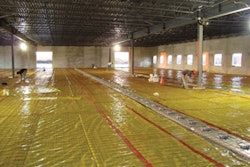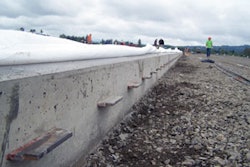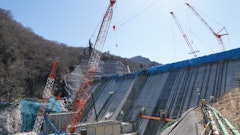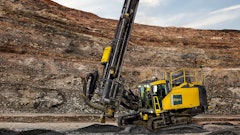The economic momentum that gathered steam during the early part of 2010 has ebbed. This was expected as growth transitioned from stimulus- and inventory-fueled to core fundamentals such as consumer spending, investment and net exports. The economic recovery scenario can best be described as a synchronized recovery - reflecting the self-sustaining momentum and the interplay of marginal increases in demand, prompting job gains and feeding consumer, business and bank optimism - leading to further marginal gains in demand. The scenario reflects a gradually building private sector momentum - something essential given the winding down of the stimulus.
Residential outlook
Homebuilders are unlikely to significantly accelerate construction activity until two critical conditions are met, including: 1) low levels in inventory of unsold new homes reflecting no higher than a five-month supply, and 2) stable or rising home prices. Both conditions are likely to be required to ensure an adequate ROI for homebuilders to spur an increase in building activity. Lacking either condition, a substantive recovery in home building will not materialize.
Given this, analysis of the residential sector becomes very simple. A significant improvement in residential construction cannot begin until the foreclosure crisis is over. This is not expected to materialize until 2012.
The overall number of mortgage resets are expected to decline in 2011. To some, this could imply a reduction in foreclosures next year. Unfortunately, the type of mortgages that are due for reset are extremely toxic. This suggests a greater default rate and, as a result, foreclosure levels that are likely to match 2010 record levels.
The Portland Cement Association (PCA) expects a generally flat single family housing starts scenario will unfold for 2011. In 2009, single family starts totaled 440,000 units, rising to an estimated 476,000 units in 2010. PCA expects 2011 housing starts will reach 492,000 units. As labor market conditions slowly improve, lending standards gradually ease, foreclosures begin to subside and new home prices stabilize, initially tepid gains are expected to materialize. Housing starts are expected to reach 690,000 units in 2012.
Nonresidential
Nonresidential construction is not expected to recover soon. Large declines that characterized 2009 have materialized in 2010. Further, smaller declines against weak 2010 levels are expected to characterize 2011. No substantive recovery is expected in 2012.
Several issues confront a recovery in nonresidential expected ROIs and construction activity including depressed occupancy and usage rates, soft leasing rates, declining commercial asset prices and tight lending standards. The speed at which the healing process begins will be largely dictated by the strength in the labor market recovery. In light of PCA's more modest economic growth scenario, job creation is not expected to be as robust as previously expected - slowing a recovery in nonresidential construction.
PCA's nonresidential outlook suggests a prolonged recovery process. The timing of the nonresidential recovery (2013) reflects the process in which a recovery materializes - referred to as the "transmission mechanism". Given sustained job creation and a lowering of vacancy rates, the leasing rates will first stabilize and then improve. Only when both conditions are present, namely declining vacancy rates and improving leasing rates, will expected increases in NOI (Net Operating Income) materialize - igniting new interest in commercial construction activity. Unfortunately, the process will take quite some time to unfold. In addition, the commercial real estate market is plagued with refinancing issues.
Public
The public sector outlook contains political as well as economic risks - assumptions regarding both areas could have significant implications on the volume projections for cement consumption. Keep in mind, public cement consumption typically accounts for 40 to 45 percent of total United States consumption. In light of the dormant private sector cement consumption, public sector cement consumption is expected to account for 50 to 55 percent of consumption during the next two years. This implies that assumptions and assessments regarding the public sector carry more importance than usual and, as a result, can be a source of larger forecast risk.
During 2010, American Recovery and Reinvestment (ARRA) spending is on pace for $11.6 billion dollars. PCA expects $9 billion will be spent in 2011 and $600 million in 2012. The composition of projects is expected to continue to move from resurfacing to more design-intensive projects - typically carrying higher cement intensities. PCA generally believes states that have been slow to spend ARRA dollars during 2009 and 2010 are likely to see a higher commitment to "big projects."
PCA believes a new wave of fiscal conservatism has embraced Congress - perhaps ignited by Obama's health care plan - giving rise to the influence of the Tea Party's conservative agenda. Whatever the causality, the political will for further significant fiscal efforts to stimulate a fragile economic recovery now seem remote. Given this, PCA believes the current political realities translate into no new highway bill materializing until 2013. If an earlier than expected highway bill materializes, PCA's current forecast could underestimate 2012 cement consumption accrued to highway spending.
PCA's political assumptions imply that SAFETEA-LU will be extended once again. PCA assumes the extension will be at existing nominal funding levels. Last year the extension did not materialize until April 2010. This seven-month delay resulted in a shortfall of funds prompting some projects to be stopped and/or delayed. While some of this delay may have been captured later in the year, PCA believes 1 million to 2 million tons of cement consumption was lost for 2010 due to delays in the passage of the SAFETEA-LU extension. No doubt the delay resulted in some unexpected weakness in cement consumption. The delay in the extension impacts timing, not necessarily the cement volume associated with SAFETEA-LU, and implies that 1 million to 2 million tons of cement consumption could be recaptured in 2011. Assuming 2011 extensions are not delayed, this implies a 2010 to 2011 net increase of 2 million to 4 million metric tons in SAFETEA-LU cement consumption for 2011 (no loss of 1 million to 2 million as in 2010, plus recapture of lost 2010 volume).
As of press time, no extension of SAFETEA-LU for next year has materialized. It was set to expire on December 31. At this time, PCA believes there is a 50/50 chance that extension will be voted on during the lame-duck session. If not, it is likely that an extension will not materialize until April 2011. PCA's current forecast assumes a lame-duck passage.
Finally, state and local fiscal conditions play an important role in determining the public sector's near-term growth path. Large state deficits are expected to continue in 2011, improving in 2012 with small surplus conditions materializing in 2013. Given the magnitude of the economic distress, deficit conditions could have been much worse had state governments not reacted quickly with expenditure cuts - including massive state construction cutbacks. The "easy" cuts have been made and to the bone, leaving little additional leverage on the expenditure side and implying no further significant drag on 2011 cement consumption.
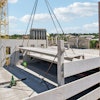


![Fcp Racatac Chair 10893876[1]](https://img.forconstructionpros.com/mindful/acbm/workspaces/default/uploads/2025/10/fcp-racatac-chair-108938761.10l0At5WXv.png?auto=format%2Ccompress&bg=fff&fill-color=fff&fit=fill&h=100&q=70&w=100)

